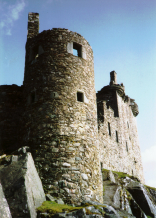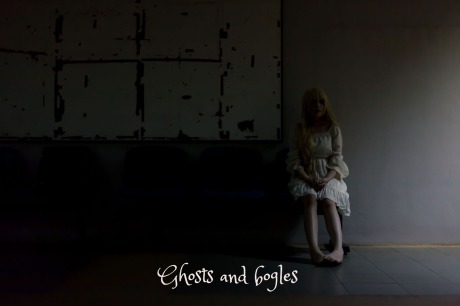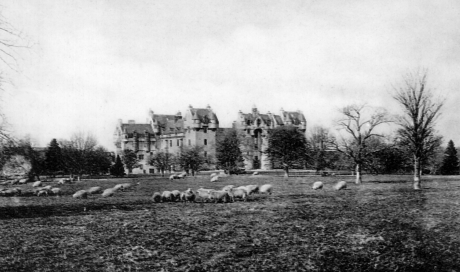Lillias Drummond and the Ghosts of Fyvie
Many hundreds of places in Scotland are reputedly haunted. Often it is possible to at least guess who (in life) the ghost was: a murder, a suicide, an untimely death, a tragic life indicate the identity, or perhaps from a portrait or a ghost being observed by a loved one or by an acquaintance.
But in one case (if the story is to be believed) at Fyvie Castle, the ghost left proof positive of both its presence and its name. For, some fifty foot above the ground and carved outwards into a window sill, in finely sculpted letters, are the words:
D[ame] LILLIES DRUMMOND
Nor is there any dispute about this part of the ghost story. Fyvie Castle is in the care of The National Trust of Scotland and is open to the public – and a visit to the Drummond Room of the castle will confirm the existence of the writing as described.
So who was Lillias Drummond and why would she haunt Fyvie Castle?
Lillias Drummond was born about 1574, and was the daughter of Patrick Drummond, third Lord Drummond, and Lady Elizabeth Lindsay. She was married to Alexander Seton in 1592, when she was seventeen or eighteen; he was in his mid thirties.
Seton was a man on the way up in James VI’s Scotland. He was a judge and Lord President of the Court of Session, commendator (administrator) of Pluscarden Abbey, and then Lord Fyvie from 1598. Fyvie Castle, the seat of the estate and some miles from Turriff in Aberdeenshire in the north-east of Scotland, is a spectacular building, extended down the centuries by a succession of owners (of whom the Setons were neither the first nor the last).
Seton went on to be become Earl of Dunfermline in 1606 and was also Chancellor of Scotland, making him one of the most important men in Scotland. Not that Lillias lived to see either of these last two honours, as she was dead by then.
It could well be that Seton believed that he was creating a dynasty, and for a dynasty a man needs, at least, one son.
There is nothing to suggest that Lillias was not a wife of impeccable character, but unfortunately, although she give birth to four daughters (Anne, Isobel, Margaret and Sophia) who survived into adulthood (another daughter died in infancy and there may have been other miscarriages), she did not produce a son.
Not that she should have been held responsibility for that, of course.
On the 8th of May 1601 Lillias died, at the age of about twenty-seven years old, young even for the turn of the seventeenth century.
In some accounts foul play has been suggested – in fact, that Seton deliberately starved Lillias to death – but there is no evidence for this, nor does it seem likely that Lillias’s powerful family would not have intervened should this have happened; indeed, Seton remained on good terms with the Drummonds.
It is possible, of course, that Lillias died of a broken heart because of ill treatment or infidelity on Seton’s part, but more likely giving birth five times, and perhaps being pregnant even more often, in the space of ten years was sufficient.
Lillias had died at Seton’s house in Fife at Dalgety, which was his favourite residence, although the location of this building is now no longer certain. She was buried in the Seton vault at nearby St Bridget’s Kirk (and where he was also buried in 1622 after dying at Pinkie House, another of his properties). The ruins of the church are open to the public and may be visited.
Whatever the truth of her early death, within six months (in fact he was betrothed in just a few weeks), Seton had remarried, wedded to his step-niece, the young Grizel Leslie, on the 27th of October 1601.
The newly weds spent their wedding night in what is now known as the Drummond Room at Fyvie Castle. This was a night they were to remember, perhaps for the wrong reasons.
All night Seton and Grizel were disturbed by sighing and moaning coming from one of the windows, which they perhaps initially dismissed as just the wind. When it was light enough to see, however, they found the letters (as mentioned before), facing outwards, distinctly carved into the outside of the window sill, reading:
D[ame] LILLIES DRUMMOND
This must have been a little disconcerting, should it be true. A window sill, after all, facing out, is a very strange place for Lillias to have had her name carved before she was dead – or for an existing stone to be reused. Of course, that does not mean it was carved by her ghost!
That the castle was believed to be haunted, however, is clear as a ‘Green Ladye’ is mentioned in documents dating from the seventeenth century.
Hauntings continued into the nineteenth century. The ghost was reputedly most often seen on the main stair (a maid described observing a lady she did not know in a green dress ascending the steps, not realising it was the Green Lady) but also in the corridor to the Douglas Room (or the Murder Room, as it is also known, where there are said to be blood stains).
The Green Lady is said to herald a death or misfortune in the resident family, not just the Setons, as that line became extinct, after Fyvie had been bought by the Gordons.
The ghost is said to have made her presence felt before the death of the then laird of Fyvie, Colonel Cosmo Gordon, in 1879, when he saw the apparition beckoning to him from the shadows of his chamber.
Then a few days later, Cosmo’s younger brother saw the ghost again, this time in the Drummond Room, when it is reported she curtseyed. Cosmo died the next day.
Before that, he is reported to have been shaken out of his bed by invisible hands, and on a later occasion a great blast through the building blew the covers off several beds in which guests and family were sleeping. Alexander Gordon saw the ghost a few years later, just before his own death.
One account has the phantom being observed with a candle in its hand and pearls in its hair, and describes how it wore a green brocade dress, and emitted a soft illuminance.
The Green Lady has also been reported as a shifting patch of light or as a flickering glow, witnessed often at night in one of the bedchambers.
Activity has continued into recent times and a visitor told one of the guides, who are on hand in many of the chambers, that she had seen the phantom of a lady in the Gordon Bedroom.
The presence of the ghost is also said to be heralded by the smell of roses, including during an instance in 2008 when one of the room guides witnessed the perfume and then felt as if an invisible person was pushing past them.
The manager and keeper of the castle, who has lived on the top floor of the building for many years, reported in 2012 many unexplained occurrences, including objects going missing or being moved about, as if by invisible hands.
Activity is believed to be worse in September and October, which would be around the anniversary of the marriage to Grizel Leslie in 1601.
He also told of a female guest in that year waking to find the apparition of a green lady at the end of her bed. The screams of the visitor woke her husband, and he smelt ‘old fashioned’ perfume, which lingered for hours.
A paranormal investigation of the castle was made in 2008 by East of Scotland Paranormal, during which unexplained events were recorded on equipment including noises.
Grizel Leslie, Seton’s new wife, herself, was also not to live into old age, and died only five years after she was married. She had three children in this brief time, and they did have a son, but he died young. Their two daughters were called Jean and Lillias.
Seton then married Margaret Hay, by whom he had several children, including Charles, who became second Earl of Dunfermline. Alexander Seton, himself, died in 1622, while Margaret Hay was to live for nearly another forty years.
The Seton Earls of Dunfermline did not survive the next generation, and James, the fourth Earl (and Alexander Seton’s grandson), was forfeited in 1690, fled abroad and died four years later, without heirs and in poverty. The title became extinct and Fyvie went to the Crown until 1733 when it was acquired by the Gordons.
Seton was buried at St Bridget’s Church at Dalgety, alongside Lillias and Grizel Leslie, and later Margaret Hay and some of his children. There are a series of striking and macabre burial markers in and around the church, adorned with skulls.
Lillias’s four daughters married into the noble families of Scotland: Anne, the Erskine Earls of Kellie; Isobel, the Maitland Earls of Lauderdale; Margaret, the Mackenzie Earls of Seaforth; and Sophia, the Lindsay Lords and later Earls of Balcarres.
This is not the only tale of ghosts at Fyvie.
The castle also has a Grey or White Lady, the story going that a young woman was starved to death (anyone who tried to rescue her was slaughtered) in a secret chamber behind what is now the Gun Room, perhaps during the time when the castle was held by the Meldrums. The small room was discovered in the 1920s when workmen were altering the building, and found her remains.
When the bones were buried, activity and disturbances became worse, and the ghost is said to have been particularly active in the 1920s and 1930s. One account describes a woman in a white flowing dress, who sailed across a room and disappeared through a door.
Manifestations apparently lessened when the remains were returned to the secret chamber and sealed within. It is possible, of course, that Lillias’s manifestations and story behind her appearance and that of this Grey or White Lady have become confused.
There is also a further spooky tale about a phantom trumpeter (or a drummer, depending on the version).
The story comes from around the eighteenth century. The ghost is believed to be the spirit of Andrew Lammie, who fell in love with Agnes Smith, daughter of the local miller. The match was doomed and Andrew disappeared, either sent off to Edinburgh, or sold into slavery, a disappearance in which the laird of Fyvie may have had a hand.
Lammie’s love wept herself into an early grave (or perhaps she was even murdered by her parents). Andrew eventually returned to Scotland, weak and ill, and found Agnes dead.
Before expiring himself, he cursed the lairds of Fyvie, declaring that he would return and his trumpet would be heard, both within the walls and outside the castle, whenever one of them was near death.
And a further eerie story is that when Fyvie was first built, stones are said to have been removed from a local chapel, and some of these fell into a river. Thomas the Rhymer, the famous thirteenth-century poet and seer, tried to visit Fyvie, but he was refused entrance.
Thomas prophesied that unless three lost stones were recovered the property would never be held by the same family for more than two generations.
Only two of the stones were recovered: one is in the Charter Room, while another is said to be built into in the foundations.
The stones are said to weep, to ooze, when tragedy is going to occur. The stones do, or did anyway, ‘weep’. This can be explained by climactic conditions as at least one of the stones is made of a porous sandstone, which absorbs and exudes water, depending on humidity.
text from Scotland's Ghastly Ghosts
More info on Fyvie Castle from thecastlesofscotland.co.uk











